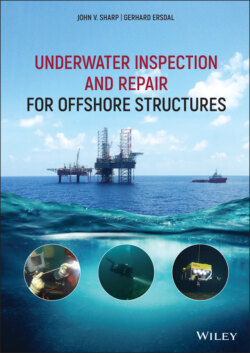Читать книгу Underwater Inspection and Repair for Offshore Structures - Gerhard Ersdal - Страница 30
2.3.2 API RP‐2A and API RP‐2SIM (Structural Integrity Management)
ОглавлениеAPI RP‐2A has since 1969 been providing guidance for offshore structure, including surveys (inspections) during operation. The required surveys range from a minimal annual inspection (level I) to more extensive inspections at longer intervals (levels II–IV), depending on manning levels and exposure (API 1993). This approach has since been taken up by other standards. A brief overview of the required surveys required for manned and unmanned platforms is shown in Table 1.
Table 1 Inspection Intervals According to API RP‐2A (API 1993).
| Interval years for manned platforms | Interval years for unmanned platforms | |
|---|---|---|
| Level I inspectionEffectiveness of CP systemAbove water visual survey In the event of suspected underwater damage, a level 2 survey was stated to be required. | Annual | Annual |
| Level II inspectionGeneral underwater visual surveyDamage surveyDebris surveyMarine growth surveyScour surveyAnode surveyCathodic potential The detection of significant structural damage is stated to be the basis for a level 3 survey. | 3–5 years | 5–10 years |
| Level III inspectionVisual inspection of preselected areas or areas with known or suspected damageCleaning of marine growth The detection of significant structural damage is stated to require a level 4 survey | 6–10 years | 11–15 years |
| Level IV inspectionUnderwater NDT of preselected areas or areas with known or suspected damageDetailed inspection and measurement of damaged area | Dependant on outcome of level III inspection | Dependant on outcome of level III inspection |
API RP‐2SIM (API 2014b) was developed from the API RP‐2A (API 2000), ISO 19902 (ISO 2007) and industry best practices. The aim was to provide a stand‐alone recommended practice (RP) for structural integrity that clarified the link between platform data, risk categorisation, fitness‐for‐purpose (FFP) assessment and inspection. The risk categorisation depends on the likelihood of failure and the consequences from failure, in terms of manning level and environmental exposure. The risk categories are expressed as L‐1 to L‐3, with L‐1 being the higher risk platforms (typically manned or high environmental consequence).
The RP builds upon the required survey intervals as shown in Table 1 and includes a simplified risk‐based methodology for inspection planning. Further, the RP details engineering practices for the evaluation, assessment and inspection of existing fixed offshore structures to demonstrate their fitness‐for‐purpose.
The RP describes the recommended SIM process, with details of each aspect of the process, as shown in Figure 8. As can be seen, the damage evaluation, assessment process, risk reduction (e.g. repair), the inspection plan and scope are of particular relevance to this book.
Figure 8 Main SIM process of API RP 2SIM (API 2014b) and follow‐on steps.
Source: Modified from API (2014b), API RP‐2SIM Recommended Practice for Structural Integrity Management of Fixed Offshore Structures, American Petroleum Institute, 2014.
The RP requires a baseline underwater inspection to be undertaken to determine the as‐installed platform condition. The baseline underwater inspection should include a visual survey of the platform for structural damage and the presence and condition of anodes and installed appurtenances. Further, the RP requires routine underwater inspections to be conducted to provide the information necessary to evaluate the condition of the platform and appurtenances. A plan for these routine inspections, depending on the risk evaluation, is provided in API RP‐2SIM (API 2014b) giving the intervals and scope for the inspections, the tools and techniques to be used and the methods of deployment.
A simplified risk‐based approach to inspection was introduced in API RP 2SIM (API 2014b). Intervals for level II inspection were stated depending on risk levels (manning level and likelihood of failure). The risk‐based inspection programme should also specify if level III or level IV inspections are required. Damage or deterioration found during a level II inspection may trigger a level III or level IV inspection. This risk‐based approach is used to redefine the inspection intervals as shown in Table 1, allowing for longer intervals for low likelihood of failure L‐1 platforms but also requiring shorter intervals for high likelihood of failure L‐2 platforms. The setting of inspection intervals for level II inspections greater than 10 years for L‐1 platforms requires the operator to demonstrate a number of factors, including that the platform is unmanned and that the annual level I CP readings are performed and are acceptable.
API RP‐2SIM (API 2014b) states that flooded member detection (FMD) can provide an acceptable alternative to close visual inspection of preselected areas in a level III survey. Engineering judgment should be used to determine the optimum use of FMD and close visual inspection of joints. Close visual inspection of pre‐selected locations for corrosion monitoring should be included as part of the level III survey.
Inspection tools and techniques are covered in general terms in API RP‐2SIM (API 2014b), including details of the standard methods as covered in Chapter 4 of this book. Evaluation of damaged components and repair is addressed in the recommended practice in line with Chapters 7and 8 of this book. The standard also addresses the structural assessment process, outlining a series of approaches. Four different levels of assessment are developed, which include:
simple methods, e.g. comparison with a similar platform;
design methods, e.g. linear (elastic) methods to check the platform member‐by member, similar to the approach used for the design of new platforms;
ultimate strength method, e.g. using a non‐linear or equivalent linear method to determine platform performance on a global basis;
alternative methods, e.g. using historical performance of the platform or explicit probabilities of survival of the platform for the assessment.
Personnel qualifications are listed for personnel responsible for conducting the evaluation and developing the inspection strategy, as further discussed in Section 4.4.5.
